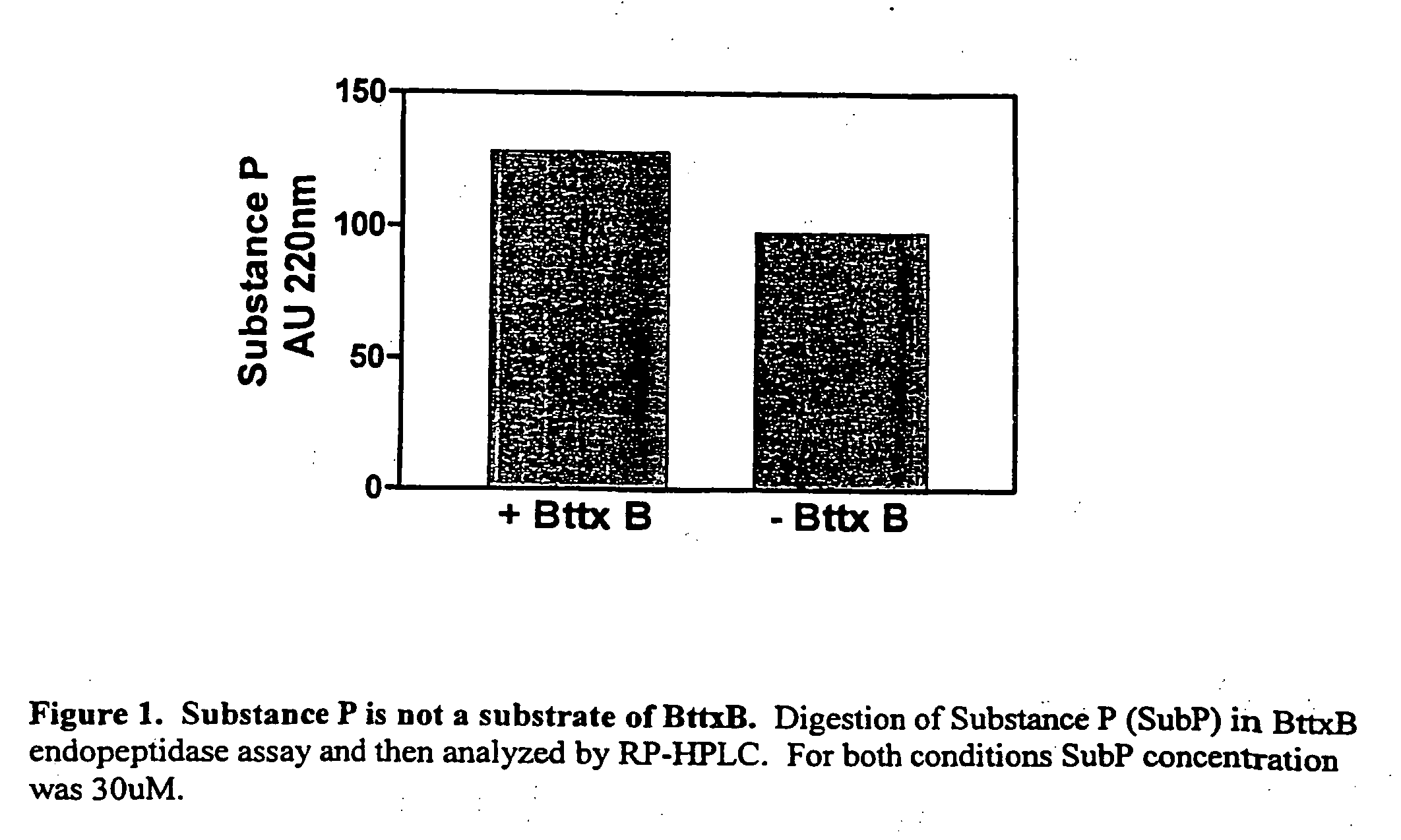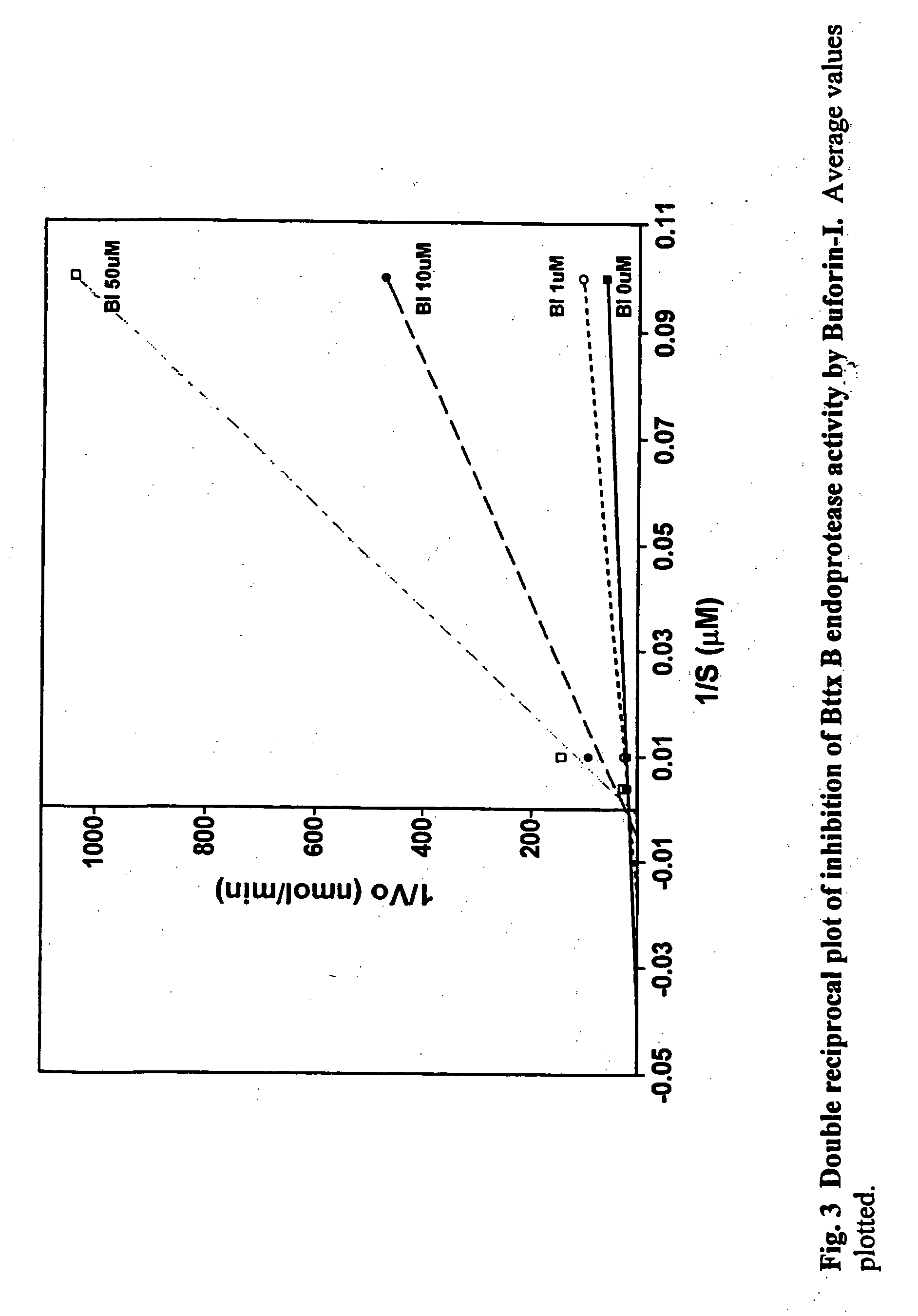Previns as specific inhibitors and therapeutic agents for Botulinum toxin B and Tetanus neurotoxins
- Summary
- Abstract
- Description
- Claims
- Application Information
AI Technical Summary
Benefits of technology
Problems solved by technology
Method used
Image
Examples
example 1
Endopeptidase Activity Assay
[0110] The toxin was activated immediately prior to use by incubating at 25° C. for 30 minutes in an activation mixture that contained, in a volume of 7.5 μl per digest: 2.4 μg (16 pmol) of toxin, 30 mM NaHEPES buffer, pH 7.3, and 5 mM DTT or TCEP. A substrate peptide mix was prepared that contained 1 nmol of the substrate peptide (VAMP2 55-94), 4% DMSO, 4% Triton X-100, and 80 mM NaHEPES buffer, pH 7.3, per digest. The final reaction mix was made by adding 25 μl of the substrate peptide mix, 4.5 μl of fresh 10 mM DTT, 13 μl H2O or test peptide, and 7.5 μl of activation mixture. The reaction was initiated by incubation at 37° C.. The reaction was stopped by the addition of 1 vol trifluoroacetic acid (TFA) to 0.25%. The samples were clarified by centrifligation.
[0111] In this assay, 16 pmol of BttxB digested 1 nmol of the substrate to completion in less than 45 min. at 37° C..
example 2
Reverse Phase HPLC Analysis of Digestion Products
[0112] Digested peptide products were fractionated by RP-HPLC on a Waters:Bondapak analytical C18 column (3.9 mm×30 cm) attached to Beckman 126 pumps and a model 168 Diode Array Detector, controlled by Beckman System Gold Ver 8.1 software. The solvent system consisted of buffer A (BA; H2O-0.1% TFA) and buffer B (BB; CH3CN-0.1%TFA). The development program consisted of the following: 97% BA, 0-1 min; to 33% BB, 1-30 min; then wash with 97% BB for 5 min, followed by equilibration in 97% BA for 10 min. The flow rate was ml min−1 except during the wash and equilibrium phase where it was 1.5 ml min−1. 75 μl injections were made with a Waters Intelligent Sample Processor (WISP Model 712). The effluent was monitored at dual wavelengths of 205 and 280 nm.
[0113] Initially, digestion products are identified by peptide sequencing using automated Edman-degradation on an ABI 477A protein sequencer attached in-line with a HPLC (ABI model 120A) fo...
example 3
Secondary Structure Predictions
[0114] Secondary structures were predicted by using the nnpredict, and the Gibrat (GOR2) programs. See McCleland, D. G, Rumelhart D. E. In Explorations in Parallel Distributed Processing. vol. 3:318-362. 1988. MIT Press, Cambridge Mass.; Kneller D. G., et al. (1990) J. Mol. Biol. 214:171-182; Garnier, J. et al. (1978) J. Mol. Biol 198;425-443; Garnier J. et al. (1987) J. Mol. Biol. 120:97-120; Garnier, J., et al. (1996) Methods Enzymol. 266:540-553. Helical wheel projections were made using the Antheprot program Ver 4. See Deleage, G., Instit de Biologie et Chimi des Proteins, Lyon, France.
[0115] The Gibrat program predicts that B-I could form an alpha-helical-turn-alpha-helical configuration similar to that of VAMP2. See Table 3. The result that Buforin I may form a secondary structure similar to VAMP2 then suggests that B-I may also form a similar supersecondary structure of a reverse turn with helix bundling similar to VAMP2. See Lebeda, et. al. (...
PUM
| Property | Measurement | Unit |
|---|---|---|
| Fraction | aaaaa | aaaaa |
| Solubility (mass) | aaaaa | aaaaa |
| Biocompatibility | aaaaa | aaaaa |
Abstract
Description
Claims
Application Information
 Login to View More
Login to View More - R&D
- Intellectual Property
- Life Sciences
- Materials
- Tech Scout
- Unparalleled Data Quality
- Higher Quality Content
- 60% Fewer Hallucinations
Browse by: Latest US Patents, China's latest patents, Technical Efficacy Thesaurus, Application Domain, Technology Topic, Popular Technical Reports.
© 2025 PatSnap. All rights reserved.Legal|Privacy policy|Modern Slavery Act Transparency Statement|Sitemap|About US| Contact US: help@patsnap.com



